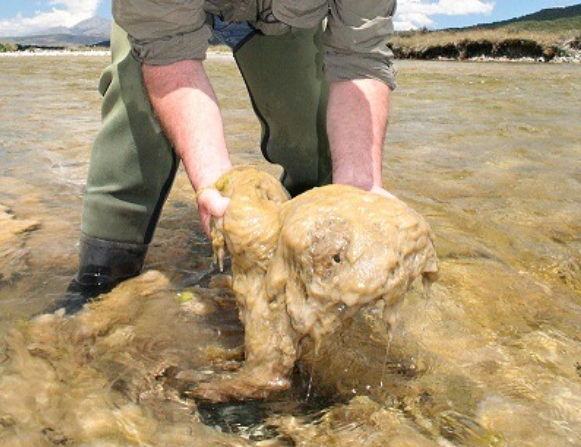By Matt Barney
A new Angler Science project from Trout Unlimited aims to mobilize our members to contribute their field observations and help scientists understand an organism that can dramatically impact trout waters.
Didymo, more colorfully known as rock snot, has been labeled an invasive species in the past, and many anglers associate it with the ban on felt-soled waders issued in many states. But more recently scientists have found Didymo in very remote streams where invasion seems an unlikely explanation for its presence. In addition some research suggests that Didymo is native in many places where it had previously been considered an invader. Amazingly, anthropologists from the University of British Columbia have reported fossil evidence showing Didymo was present in North America at least 11,000 to 12,000 years ago.
In addition to questions about its status and spread, Didymo’s growth patterns are a bit mysterious. The nuisance mats, or “blooms,” are what Didymo is most known for, but some Didymo communities seem to thrive without forming the stalks that result in nuisance algal mats. Didymo is a microscopic diatom, a form of alga, and while we usually think of seeing algae infestations in waters where nutrient levels are high, such as places with agricultural or septic contamination, the Didymo organism is a little different. Scientists have found that it forms mats primarily in waters that are low in dissolved phosphorus, and in a recent note in Frontiers in Ecology and the Environment, researchers show that high phosphorus levels seem to lead Didymo to create more cells, without building the long stalks that result in thick blooms. Despite these important clues, much remains unknown about why and when Didymo forms mats, as well as why and when it does not.
 alt=”” title=”” />It all adds up to Didymo being a bit of a puzzle, one that anglers can help solve. TU’s Science Team has teamed up with Dr. Brad Taylor at North Carolina State University to launch a pilot project called D3: Discovering Didymo’s Distribution. Armed with smartphones and sampling kits, volunteer angler scientists are using Dr. Taylor’s protocol to collect algae specimens and photographs of sample sites. Observers then note the overhead canopy and streambed characteristics and upload these data into a custom iNaturalist app and mail their specimens to the NC State lab for analysis. Dr. Taylor’s lab will map each sample site according to the presence or absence of Didymo, as well as noting which ones have Didymo mats. All of these data will build a crowdsourced geographic database that gives researchers places to test hypotheses in their quest to understand Didymo and unravel its mysteries. The pilot phase of D3 is running in the Southern Appalachians, and once everything is working smoothly, we’ll expand the project to other areas, with opportunities for a lot more volunteers to contribute. Stay tuned to this blog and to our Angler Science page for more updates.
alt=”” title=”” />It all adds up to Didymo being a bit of a puzzle, one that anglers can help solve. TU’s Science Team has teamed up with Dr. Brad Taylor at North Carolina State University to launch a pilot project called D3: Discovering Didymo’s Distribution. Armed with smartphones and sampling kits, volunteer angler scientists are using Dr. Taylor’s protocol to collect algae specimens and photographs of sample sites. Observers then note the overhead canopy and streambed characteristics and upload these data into a custom iNaturalist app and mail their specimens to the NC State lab for analysis. Dr. Taylor’s lab will map each sample site according to the presence or absence of Didymo, as well as noting which ones have Didymo mats. All of these data will build a crowdsourced geographic database that gives researchers places to test hypotheses in their quest to understand Didymo and unravel its mysteries. The pilot phase of D3 is running in the Southern Appalachians, and once everything is working smoothly, we’ll expand the project to other areas, with opportunities for a lot more volunteers to contribute. Stay tuned to this blog and to our Angler Science page for more updates.
For those of you attending the 2017 Southeast Regional Meeting in Gatlinburg, Tenn., Dr. Brad Taylor will be giving a presentation on the causes and consequences of Didymo blooms.
Matt Barney is the senior programmer for TU’s Science Team. He is based out of Boise, Idaho.



